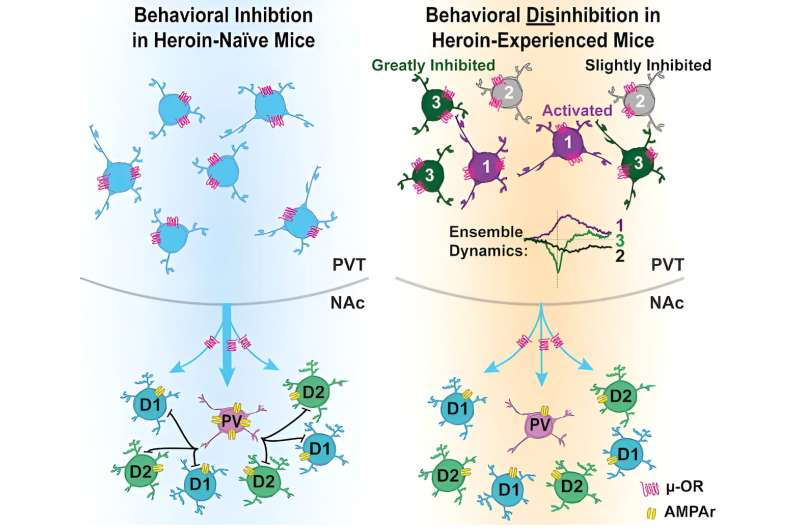This article has been reviewed according to Science X's editorial process and policies. Editors have highlighted the following attributes while ensuring the content's credibility:
fact-checked
peer-reviewed publication
trusted source
proofread
Preventing relapse by restoring an opioid-weakened brain pathway governing behavior

Medical University of South Carolina scientists report in Neuron that they have uncovered a way to restore an opioid-weakened brain pathway in a preclinical model.
The MUSC research team, led by neuroscientist James Otis, Ph.D., used advanced neuroscience tools to return a pathway between the thalamus and basal ganglia to healthy functioning in mice. As a result, this restoration prevented mice that were opioid-dependent from seeking or self-administering heroin. Results also suggested that sustained opioid use was the cause of this weakened pathway, rather than being caused by it.
"Our study is the first showing that this pathway, associated with the capability of stopping behavior, can be 'rescued' after being weakened by opioid use," Otis said.
Otis was surprised that not only could this brain pathway be returned to healthy functioning, but that its recovery prevented relapse.
"When we brought this brain circuit back to what we think of as a healthy state, we were excited to see that it could inhibit behaviors such as relapse," said Otis.
This pathway of neurons identified by Otis' team is critical for controlling or stopping behavior—also referred to as behavioral control. Difficulty stopping is a hallmark feature of many neuropsychiatric disorders, including substance use disorders. The capacity to stop is a critical skill in recovering from drug dependence and avoiding relapse.
Studies have shown that people with substance use disorders find it more difficult to stop behavior, he explained. In previous studies, they took longer to pause behavioral tasks than those without a history of substance use.
Difficulty stopping is a key reason why people with substance use disorders may continue to use substances despite negative consequences or despite their desire to stop. Restoring behavioral control could improve their ability to stop such behaviors and remain drug abstinent.
Researchers have identified pathways in the brain that influence our capacity to stop different behaviors. For example, our brains can stop motor movement when two regions of the brain—the prefrontal cortex and basal ganglia—talk to one another.
The prefrontal cortex makes the decision to stop and sends this message to the basal ganglia. The basal ganglia then prevents the movement. The communication between these areas of the brain has been shown to be disrupted in people with substance use disorders, helping to explain the challenges they face with this skill.
Expanding on this research, Otis and his team identified a new pathway of neurons in mice involved with stopping behavior. In a previous study, his team found that this series of neurons, beginning in the thalamus, similarly communicated with the basal ganglia to control movement.
This study reported in Neuron helps to resolve a long-standing chicken-or-egg debate about the relationship between difficulty stopping behavior and substance use disorder. Does an impaired capacity to stop increase the likelihood that someone will later develop a substance use disorder? Or does repeated drug use weaken the parts of the brain involved with this ability?
"We wanted to know more about how opioid use influences these neurons, or if instead these neurons are already impaired in those who are vulnerable to future opioid addiction," Otis explained.
Findings from this research strongly suggest that the weakening of this pathway happens because of opioid use, rather than being a cause of opioid use. After two weeks of opioid use by the mice, Otis and his team observed that this pathway became half as strong as it was prior to drug use.
The next step is to see if these results can be repeated with substances such as alcohol, methamphetamine, amphetamine and cocaine.
The experimental techniques used to restore this brain circuit in a preclinical model are not suitable for human studies. However, Otis can envision that future drug treatments could rehabilitate brain functioning associated with drug use.
"The goal of addiction treatment should be to recover healthy brain circuitry, rather than just prevent relapse or prevent the symptoms of addiction," said Otis.
More information: Jacqueline E. Paniccia et al, Restoration of a paraventricular thalamo-accumbal behavioral suppression circuit prevents reinstatement of heroin seeking, Neuron (2023). DOI: 10.1016/j.neuron.2023.11.024





















